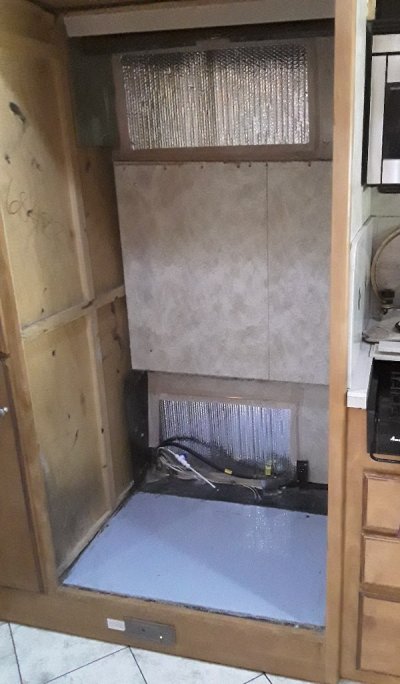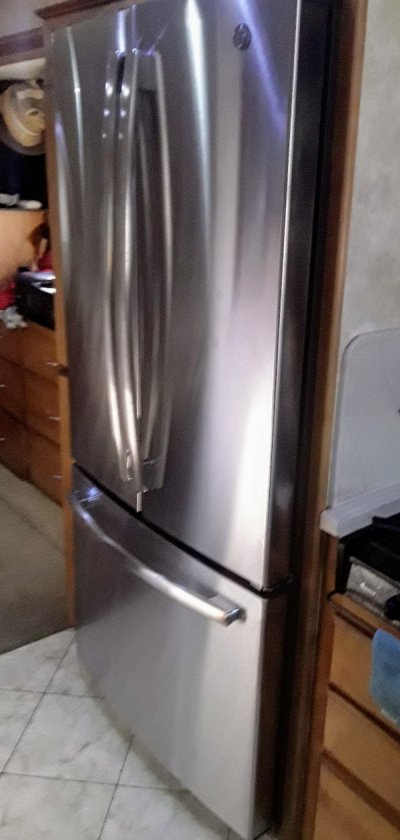Ernie n Tara
Well-known member
My current endeavor is replacing my expired Norcold 2400 RV fridge with a residential. I thought my selection process might be helpful. So:
Starting point
1. Norcold 2400 measuring 33 by 24.1/2 (approx) by 63.5 inches
2. Weight 250 lb. plus
3. Installed in a full body slide
4. Cutout 63-3/8 by 33 inches
5. Depth of cavity 28 inches total less about 3-inches of high density foam on rear wall and hookups as below
6. Electric, gas, and water located at the outside wall (occupy about 2 inches at outside wall)
7. False floor located about two inches above the slide floor
8. Facing wood 7-inches below and 3.5 inches above cutout. With propane detector centered below in 5.5 by 2 cutout below
9. About 3/8 inches clearsnce on both sides behind facing
The above dimensions equate to a 33 inch wide, counter depth (28 inches), standard refrigerator which is usually 70 inches tall.
My initial candidate was a Samsung since there are many references to these being selected by others. They are available to fit the specified dimensions, including 28 inch depth (without doors) and 70 inches tall, but appear to have significant design deficiencies and I could find no one who would recommend them! Also Samsung has a terrible reputation for not supporting them. I also wanted to avoid relocating the service connections if possible.
Final candidate selected after days of searching is a GE French Door refrigerator (GWE19JSLSS) whose significant characteristics are:
1. 32-3/4 by 69-3/4 by 24-1/8 inches (without doors which extend into aisle)
2. 18.6 cu. ft.
3. Weight of 232 lbs.
This unit will fit with only minor modifications in the available space:
1. To accomodate the additional height I have to remove the false floor for 24-1/8 inches minimum to lower the base about 3 inches.
2. I have to relocate the propane detector to a nearby spot (there's even enough wire to reach)
3 I must remove facing for three inches at bottom and top. Both are otherwise clear
4. I will use the large steel brackets I saved from the Norcold unit to stabilize and support the lower back
5 I will make new bracket for the back top to complete stabilizing
6. I will connect the refrigerator
7. I may either screen or insulate the access doors
Since I haven't received the fridge, I may find other minor adaptions, but that is basically it!
Ernie
Starting point
1. Norcold 2400 measuring 33 by 24.1/2 (approx) by 63.5 inches
2. Weight 250 lb. plus
3. Installed in a full body slide
4. Cutout 63-3/8 by 33 inches
5. Depth of cavity 28 inches total less about 3-inches of high density foam on rear wall and hookups as below
6. Electric, gas, and water located at the outside wall (occupy about 2 inches at outside wall)
7. False floor located about two inches above the slide floor
8. Facing wood 7-inches below and 3.5 inches above cutout. With propane detector centered below in 5.5 by 2 cutout below
9. About 3/8 inches clearsnce on both sides behind facing
The above dimensions equate to a 33 inch wide, counter depth (28 inches), standard refrigerator which is usually 70 inches tall.
My initial candidate was a Samsung since there are many references to these being selected by others. They are available to fit the specified dimensions, including 28 inch depth (without doors) and 70 inches tall, but appear to have significant design deficiencies and I could find no one who would recommend them! Also Samsung has a terrible reputation for not supporting them. I also wanted to avoid relocating the service connections if possible.
Final candidate selected after days of searching is a GE French Door refrigerator (GWE19JSLSS) whose significant characteristics are:
1. 32-3/4 by 69-3/4 by 24-1/8 inches (without doors which extend into aisle)
2. 18.6 cu. ft.
3. Weight of 232 lbs.
This unit will fit with only minor modifications in the available space:
1. To accomodate the additional height I have to remove the false floor for 24-1/8 inches minimum to lower the base about 3 inches.
2. I have to relocate the propane detector to a nearby spot (there's even enough wire to reach)
3 I must remove facing for three inches at bottom and top. Both are otherwise clear
4. I will use the large steel brackets I saved from the Norcold unit to stabilize and support the lower back
5 I will make new bracket for the back top to complete stabilizing
6. I will connect the refrigerator
7. I may either screen or insulate the access doors
Since I haven't received the fridge, I may find other minor adaptions, but that is basically it!
Ernie


